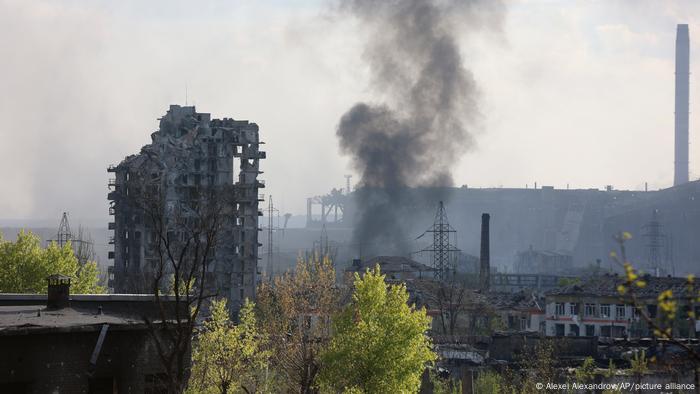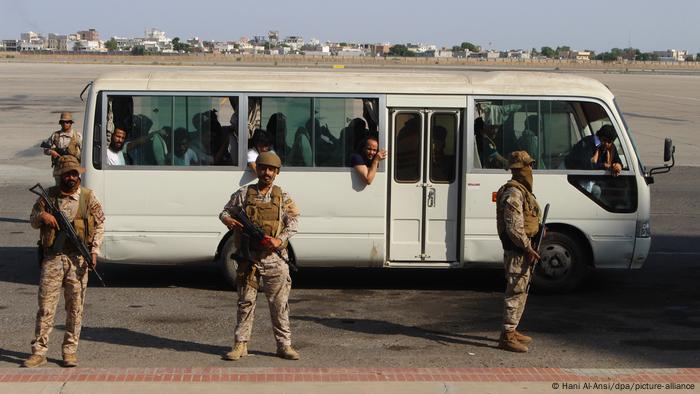The defenders of the Azov steelworks in Mariupol, Ukraine, are in Russian captivity, Ukraine is hoping for a prisoner exchange. But what exactly does that mean?

The Azov Steel Plant in Mariupol: Can the Ukrainian soldiers be released?
The future is extremely uncertain for hundreds of Ukrainian soldiers: Late Monday evening they left the Azov steelworks in Mariupol, more than 50 of them seriously injured. They were taken to a village near Donetsk – a prison camp that Ukrainian officials have already described as a concentration camp. Ukraine wants them released in a prisoner exchange. Ukraine needs its heroes alive, declared Ukrainian President Volodymyr Zelenskyy.
However, an agreement still seems a long way off: the head of the Russian parliament, Vyacheslav Volodin, has already spoken out against a general exchange. However, Russia is doing everything possible to provide medical care and humane treatment to the Ukrainian prisoners, it said. So far, the soldiers had refused to go into Russian captivity – the fear of torture or death is too great.
Who is a prisoner of war is clearly defined – but in practice looks different < /h2>
If an exchange works, it wouldn't be the first since Russia has been at war with Ukraine. For example, at the end of March this year, ten Russian soldiers were exchanged for ten Ukrainian soldiers, and according to Russian information, 41 Ukrainians were released at the beginning of May. Since the beginning of the war in eastern Ukraine in 2014, hundreds of prisoners have been exchanged between the Ukrainian government and representatives of the separatist regions. At the time, Putin spoke of “a good step forward towards normalization”.
For centuries people have pondered the question of how to deal with soldiers in captivity. The term prisoner of war is dealt with in the Geneva Conventions, part of international humanitarian law. The first convention was drawn up in 1864, and another one was decided in 1929. In 1949 both conventions were revised – also against the background of the atrocities of the Second World War. They are still valid today. Inhuman and degrading treatment are therefore prohibited.

The Ukrainian politician Ivan Fedorov was released in a prisoner exchange in April
But what exactly are prisoners of war? To be considered a prisoner of war, the person concerned must have participated in a conflict or be a member of a military command structure. So much for the theory. In practice, however, there are also people in captivity who do not meet this definition.
For example, a blogger from Luhansk and two football fans from the Sorya Luhansk club took part in an exchange in 2017 between Ukraine and pro-Russian rebels in the separatist-controlled areas in the east of the country. The football fans ended up in jail because of a burned Russian flag, the blogger was convicted of high treason by the separatists.
One on one – or much more?
In a prisoner exchange, the exchange is usually one-to-one – that is, two soldiers for two soldiers. But here, too, there are often exceptions. For example, in the 2017 exchange, mediated by Orthodox clergymen from Ukraine and Russia, Kyiv and the rebels agreed to exchange 306 pro-Russian separatists for 74 Ukrainian soldiers and patriots. In the end, there were significantly fewer people on the bus to the rebel area, because some had probably already served their sentences or didn't want to go there anymore.

Prisoner exchange in Yemen: Saudi soldiers guard a van carrying Yemeni Houthi prisoners
Another very prominent example: When US sergeant Bowe Bergdahl was replaced in 2014 after five years in Afghanistan, five high-ranking Guantanamo detainees were sent to Qatar under house arrest in return. The case turned into a disaster for the Obama administration Government, for critics the price for Bergdahl's release was too high.
When will the exchange take place?
Despite the numerous examples: The US author, professor and military historian Paul J. In an interview with the US news magazine “Time”, Springer explained that the number of exchanges has decreased overall. More and more prisoners have to stay until the end of the fighting. People are usually exchanged who are no longer able to fight due to illness or serious injuries.
During the Korean War, for example, many prisoners were taken only exchanged when they were about to die, according to the motto: Better to die at home than in a prison camp. In the case of the exchange that is now being discussed in Ukraine, 53 soldiers are said to be seriously injured. That may have played a role in the selection of the people.